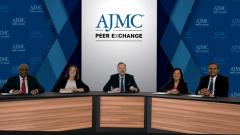
Four Pillars of Heart Failure Therapy
Therapy strategies in the management of heart failure are discussed.
Episodes in this series

This is a video synopsis/summary of a panel discussion involving Robert Groves, MD; Eugene E. Wright Jr, MD; Nancy Albert, PhD; Nihar Desai, MD, MPH; and Kelly Marie Axsom, MD. Axsom, MD, outlines the 4 pillars of guideline-directed medical therapy for symptomatic heart failure with reduced ejection fraction (HFrEF), which also applies to midrange ejection fraction (EF): angiotensin receptor-neprilysin inhibitors, angiotensin-converting enzyme (ACE) inhibitors or angiotensin receptor blockers (ARBs); evidence-based beta blockers (metoprolol succinate, bisoprolol, carvedilol); mineralocorticoid receptor antagonists (MRAs; spironolactone, eplerenone); and sodium-glucose cotransporter-2 (SGLT2) inhibitors (dapagliflozin, empagliflozin). The specific beta blockers reduce 1-year mortality by 36% based on randomized controlled trial data. For heart failure with preserved ejection fraction (HFpEF), treatment focuses on managing comorbidities until EF declines below 60% to 65%. Implementation and adherence to guideline-directed medical therapy remains a challenge. The classification system helps guide evidence-based treatments for HFrEF, while HFpEF management is more limited but evolving.
Video synopsis is AI-generated and reviewed by AJMC editorial staff.
Newsletter
Stay ahead of policy, cost, and value—subscribe to AJMC for expert insights at the intersection of clinical care and health economics.








































